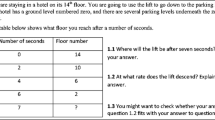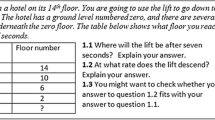Abstract
This paper arises from a study of how concepts related to understanding functions develop for students across the years of secondary/high school, using small samples from two different curricula systems: England and Israel. We used a survey consisting of function tasks developed in collaboration with teachers from both curriculum systems. We report on 120 higher achieving students, 10 from each of English and Israeli, 12–18 years old. Iterative and comparative analysis identified similarities and differences in students’ responses and we conjecture links between curriculum, enactment, task design, and students’ responses. Towards the end of school, students from both curriculum backgrounds performed similarly on most tasks but approached these by different routes, such as intuitive or formal and with different understandings, including correspondence and covariational approaches to functions.





Similar content being viewed by others
Notes
The current curriculum is similar to this description, but with more modelling and applications. There has been no major change in the age at which function is introduced explicitly.
By dividing class size by 10 to get n and then selecting approximately every nth script.
References
Ainley, J., & Pratt, D. (2005). The significance of task design in mathematics education: Examples from proportional reasoning. In H. L. Chick & J. L. Vincent (Eds.), Proceedings of the 29th annual conference of the International Group for the Psychology of Mathematics Education (Vol. 1, pp. 93–122). Melbourne: PME.
Ayalon, M., Watson, A., & Lerman, S. (2015). Functions represented as linear sequential data: Relationships between presentation and student responses. Educational Studies in Mathematics, 90, 321–339.
Ayalon, M., Watson, A., & Lerman, S. (2016a). Progression towards functions: Students’ performance on three tasks about variables from grades 7 to 12. International Journal of Science and Mathematics Education, 14, 1153–1173.
Ayalon, M., Watson, A., & Lerman, S. (2016b). Reasoning about variables in 11 to 18 year olds: Informal, schooled and formal expression in learning about functions. Mathematics Education Research Journal, 28, 379–404.
Ayalon, M., Watson, A., & Lerman, S. (2017). Students’ conceptualizations of function. Research in Mathematics Education, 19(1), 1–19.
Blanton, M. L., & Kaput, J. J. (2011). Functional thinking as a route into algebra in the elementary grades. In J. Cai & E. Knuth (Eds.), Early algebraization: A global dialogue from multiple perspectives (pp. 5–23). Berlin: Springer.
Carlson, M., & Oehrtman, M. (2005). Key aspects of knowing and learning the concept of function. Research Sampler Series, 9, The Mathematical Association of America Notes Online. Retrieved August 15, 2017, from http://www.maa.org/t_and_l/sampler/rs_9.html
Clement, J. (1985). Misconceptions in graphing. In L. Streefland (Ed.), Proceedings of the 9th annual conference of the International Group for the Psychology of Mathematics Education (Vol. 1, pp. 369–375). Noordwijkerhout: PME.
Confrey, J., & Smith, E. (1994). Exponential functions, rates of change, and the multiplicative unit. Educational Studies in Mathematics, 26, 135–164.
Confrey, J., & Smith, E. (1995). Splitting, covariation, and their role in the development of exponential functions. Journal for Research in Mathematics Education, 26(1), 66–86.
Daniels, H. (Ed.). (1993). Charting the agenda: Educational activity after Vygotsky. London: Routledge.
Dreyfus, T., & Eisenberg, T. (1983). The function concept in college students: Linearity smoothness and periodicity. Focus on Learning Problems in Mathematics, 5(3), 119–132.
Dubinsky, E., & Harel, G. (1992). The nature of the process conception of function. In E. Dubinsky & G. Harel (Eds.), The concept of function. Aspects of epistemology and pedagogy (pp. 85–106). Washington, DC: The Mathematical Association of America.
Gravemeijer, K., & Doorman, M. (1999). Context problems in realistic mathematics education: A calculus course as an example. Educational Studies in Mathematics, 39, 111–129.
Janvier, C. (1981). Use of situations in mathematics education. Educational Studies in Mathematics, 12, 113–122.
Karplus, R. (1978). Intellectual development beyond elementary school IX: Functionality, a survey (Advancing education through science oriented programs, report ID-51). Berkeley: University of California.
Leinhardt, G., Zaslavsky, O., & Stein, M. S. (1990). Functions, graphs and graphing: Tasks, learning, and teaching. Review of Educational Research, 1, 1–64.
Lerman, S. (2001). Accounting for accounts of learning mathematics: Reading the ZPD in videos and transcripts. In D. Clarke (Ed.), Perspectives on practice and meaning in mathematics and science classrooms (pp. 53–74). Dordrecht: Kluwer.
Ministry of Education. (2009). Mathematics curriculum for grades 7–9. Retrieved (in Hebrew) from http://meyda.education.gov.il/files/Tochniyot_Limudim/Math/Hatab/Mavo.doc
Monk, G. S. (1994). Students’ understanding of functions in calculus courses. Humanistic Mathematics Network Journal, 1(9), 7.
Qualifications and Curriculum Authority [QCA]. (2007). The national curriculum: Statutory requirements for key stages 3 and 4. Retrieved from http://webarchive.nationalarchives.gov.uk/20110215115220
Radford, L. (2008). Iconicity and contraction: A semiotic investigation of forms of algebraic generalizations of patterns in different contexts. ZDM – The International Journal on Mathematics Education, 40, 88–96.
Rivera, F. D., & Becker, J. R. (2008). Middle school children’s cognitive perceptions of constructive and deconstructive generalisations involving linear figural patterns. ZDM: International Journal in Mathematics Education, 40, 65–82.
Roth, W.-M., & Radford, L. (2011). A cultural-historical perspective on mathematics teaching and learning. Rotterdam: Sense.
Saldanha, L., & Thompson, P. W. (1998). Re-thinking covariation from a quantitative perspective: Simultaneous continuous variation. In S. B. Berenson, K. R. Dawkins, M. Blanton, W. N. Coloumbe, J. Kolb, K. Norwood, & L. Stiff (Eds.), Proceedings of the 20th annual meeting of the Psychology of Mathematics Education North American Chapter (Vol. 1, pp. 298–303). Raleigh: North Carolina State University.
Sfard, A. (1991). On the dual nature of mathematical conceptions: Reflections on processes and objects as different sides of the same coin. Educational Studies in Mathematics, 22, 1–36.
Sfard, A. (1992). Operational origins of mathematical objects and the quandary of reification: The case of function. In G. Harel & E. Dubinsky (Eds.), The concept of function: Aspects of epistemology and pedagogy (pp. 59–84). Washington, DC: Mathematical Association of America.
Sierpinska, A. (1992). On understanding the notion of function. In G. Harel & E. Dubinsky (Eds.), The concept of function: Aspects of epistemology and pedagogy (pp. 25–28). Washington, DC: Mathematical Association of America.
Slavit, D. (1997). An alternate route to the reification of function. Educational Studies in Mathematics, 33, 259–281.
Stacey, K. (1989). Finding and using patterns in linear generalising problems. Educational Studies in Mathematics, 20, 147–164.
Steele, D. (2008). Seventh-grade students’ representations for pictorial growth and change problems. ZDM–International Journal in Mathematics Education, 40, 97–110.
Swan, M. (1980). The language of functions and graphs. Nottingham: Shell Centre for Mathematical Education, University of Nottingham.
Tall, D. (1992). The transition to advanced mathematical thinking: Functions, limits, infinity and proof. In D. A. Grouws (Ed.), Handbook of research on mathematics teaching and learning (pp. 495–511). New York: Macmillan.
Thompson, P. W. (1994). Images of rate and operational understanding of the fundamental theorem of calculus. Educational Studies in Mathematics, 26, 229–274.
Thompson, P. W., & Carlson, M. (2017). Variation, covariation, and functions: Foundational ways of thinking mathematically. In J. Cai (Ed.), Compendium for research in mathematics education (pp. 421–456). Reston: National Council of Teachers of Mathematics.
Van Dooren, W., De Bock, D., Hessels, A., Janssens, D., & Verschaffel, L. (2005). Not everything is proportional: Effects of age and problem type on propensities for overgeneralization. Cognition and Instruction, 23, 57–86.
Vinner, S., & Dreyfus, T. (1989). Images and definitions for the concept of function. Journal for Research in Mathematics Education, 20, 356–366.
Wilmot, D. B., Schoenfeld, A. H., Wilson, M., Champney, D., & Zahner, W. (2011). Validating a learning progression in mathematical functions for college readiness. Mathematical Thinking and Learning, 13(4), 259–291.
Author information
Authors and Affiliations
Corresponding author
Rights and permissions
About this article
Cite this article
Watson, A., Ayalon, M. & Lerman, S. Comparison of students’ understanding of functions in classes following English and Israeli national curricula. Educ Stud Math 97, 255–272 (2018). https://doi.org/10.1007/s10649-017-9798-8
Published:
Issue Date:
DOI: https://doi.org/10.1007/s10649-017-9798-8




